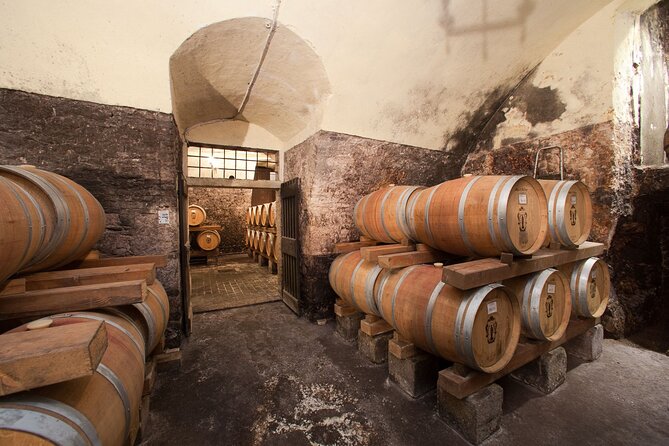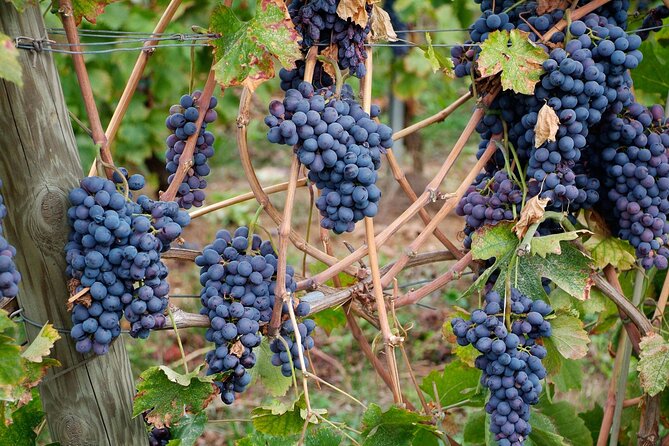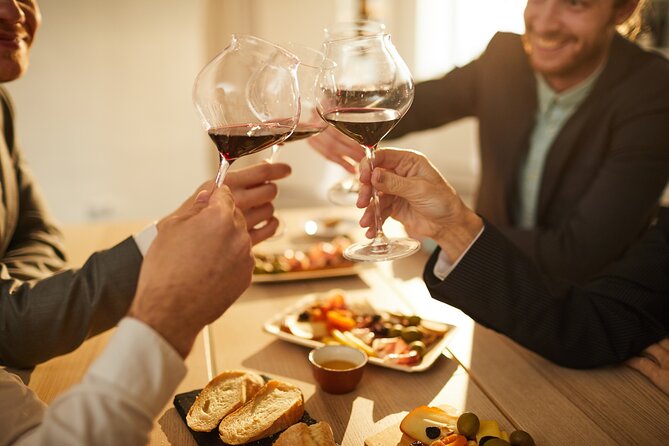Set out on a tantalizing journey through the time-honored traditions and cutting-edge advancements in Valpolicella wines.
As the sun sets over the rolling vineyards, the interplay between tradition and modernity unfolds in each sip.
Witness the evolution of winemaking techniques while savoring the complexities of Valpolicella’s finest blends.
But what secrets lie in the depths of these renowned wines, and how do they shape the future of this iconic region?
Good To Know

- Valpolicella wines embody centuries-old traditions with a modern touch.
- Fusion of traditional winemaking techniques with cutting-edge innovations.
- Reflecting the region’s unique terroir through classic and innovative practices.
- Balancing tradition and modernity to create distinctive and high-quality wines.
Valpolicella Wine Region Overview

Nestled in the picturesque hills of northern Italy, the Valpolicella wine region boasts a rich history and a vibrant blend of traditional winemaking practices with modern innovations. The area’s wine production dates back to ancient times, with evidence of Roman cultivation and appreciation for the local grapes.
Valpolicella is renowned for its red wines, particularly Amarone, Ripasso, and Valpolicella Classico, which are crafted from a variety of indigenous grapes like Corvina, Rondinella, and Molinara. The region’s distinct terroir, characterized by a mix of clay, limestone, and schist soils, contributes to the unique flavor profile of its wines.
Visitors to Valpolicella can explore historic vineyards, modern wineries, and enjoy tastings that showcase the region’s rich winemaking heritage.
Enjoying the local flavors? More Verona food experiences we've written about
Traditional Winemaking Techniques

The winemaking heritage of the Valpolicella wine region is deeply rooted in time-honored techniques that have been passed down through generations, showcasing a seamless blend of tradition and innovation. In Valpolicella, traditional practices play a crucial role in crafting high-quality wines that reflect the unique terroir of the region.
Some key elements of traditional winemaking techniques in Valpolicella include:
- Hand-harvesting of grape varietals: The careful selection and hand-picking of grapes ensure only the finest fruit is used in winemaking.
- Appassimento process: This traditional method involves drying grapes to concentrate flavors, a technique commonly used in the production of Amarone wines.
- Use of large wooden barrels: Aging wines in large wooden casks is a traditional practice that imparts subtle oak flavors to the final product.
Modern Innovations in Valpolicella Wines
Incorporating cutting-edge technology and innovative techniques, winemakers in Valpolicella are revolutionizing the traditional approach to wine production. By embracing innovative techniques and contemporary styles, these producers are pushing the boundaries of what Valpolicella wines can offer.
From experimenting with new fermentation processes to exploring novel aging methods, the modern innovations in Valpolicella wines are reshaping the industry. Winemakers are now blending traditional practices with state-of-the-art equipment to enhance the quality and flavors of their wines.
The focus on modernization not only aims to improve efficiency but also to cater to evolving consumer preferences. This dedication to innovation ensures that Valpolicella wines continue to captivate wine enthusiasts worldwide with their unique and refined characteristics.
Tasting Notes on Classic Valpolicella Wines
Embracing a rich heritage of winemaking, the classic Valpolicella wines offer a sensory journey through the traditional flavors and aromas that define the region’s renowned viticultural legacy.
Tasting Comparisons: Classic Valpolicella wines often boast a lighter body compared to their more robust Amarone counterparts, allowing for a nuanced tasting experience.
Regional Influences: The unique terroir of the Valpolicella region imparts distinct characteristics on these wines, with variations in soil composition and microclimates influencing the final taste profiles.
Historical Significance: Exploring classic Valpolicella wines provides a glimpse into the centuries-old winemaking techniques that have been preserved and passed down through generations, adding depth and cultural richness to each sip.
Exploring New Trends in Valpolicella Wines
Discovering innovative approaches to crafting Valpolicella wines adds a dynamic twist to traditional winemaking practices. In the realm of exploring trends, wine blending stands out as a prominent technique that winemakers are increasingly utilizing. By combining different grape varieties such as Corvina, Rondinella, and Molinara, vintners can create unique flavor profiles that captivate the palate.
This blending process allows for a harmonious balance of fruity notes, acidity, and tannins, resulting in wines that are complex and enjoyable. On top of that, experimenting with aging methods, like using different types of oak barrels or amphorae, contributes to the evolution of Valpolicella wines.
Embracing these new trends in winemaking showcases the industry’s adaptability and commitment to producing exceptional wines that reflect both tradition and innovation.
Interested in wine? More Verona vineyard visits we've reviewed
- From Verona: Amarone Wine Trail Tour
- Small-Group Amarone Wine E-Bike Tour From Verona
- Wine Tasting With Panoramic View of Verona
- Pagus Wine Tours – a Taste of Valpolicella – Half Day Wine Tour
- Semi-Private Amarone Wine-Tasting Tour From Verona
- 6 Wine Tasting in Valpolicella Classica: the Cradle of Amarone
Food Pairing Recommendations for Valpolicella Wines
Exploring the culinary realm that complements Valpolicella wines reveals delightful food pairing recommendations that enhance the overall tasting experience. When it comes to food pairing with Valpolicella wines, consider these exciting options:
Grilled Lamb Chops: The rich and bold flavors of Valpolicella wines beautifully complement the juicy tenderness of grilled lamb chops.
Mushroom Risotto: The earthy notes in Valpolicella wines harmonize with the creamy texture and umami flavors of mushroom risotto.
Aged Parmesan Cheese: Pairing Valpolicella wines with aged Parmesan cheese creates a delightful contrast, with the wine’s acidity cutting through the cheese’s richness for a balanced palate sensation.
These food pairing suggestions are sure to elevate your wine tasting experience and bring out the best in both the wines and the dishes.
Valpolicella Wines: Past, Present, and Future
In the evolution of Valpolicella wines, tradition intertwines with innovation to shape a dynamic path from the past into the present and towards the future. Valpolicella wines have a rich history dating back to ancient times, where traditional winemaking methods were honed and perfected. Today, winemakers are blending this heritage with modern techniques, creating a unique comparison between the old and the new. The future of Valpolicella wines lies in sustainability and innovation, as producers strive to preserve the land for generations to come while exploring new ways to enhance the quality of their wines. This evolution ensures that Valpolicella wines continue to captivate wine enthusiasts worldwide, offering a taste of the past while embracing the possibilities of the future.
| Aspect | Description |
|---|---|
| Past | Rich history |
| Present | Blend of tradition & innovation |
| Future | Focus on sustainability & innovation |
| Comparison | Old vs. new techniques |
| Evolution | Shaping the wine industry |
Common Questions
What Are the Best Wineries to Visit in the Valpolicella Wine Region for a Tasting Experience?
For a top-notch tasting experience in the Valpolicella wine region, explore wineries that offer food pairings and vineyard tours. Don’t miss out on wine festivals and meeting local artisans to truly learn about the region’s wine culture.
Are There Any Specific Grape Varieties That Are Unique to Valpolicella Wines?
Exploration of Valpolicella reveals unique grape varieties like Corvina, Corvinone, and Rondinella, defining the region’s terroir. Tasting techniques showcase the rich flavors derived from these indigenous grapes, blending tradition with modernity in every sip.
How Does the Aging Process Differ Between Traditional and Modern Valpolicella Wines?
When comparing traditional and modern Valpolicella wines, the aging techniques vary significantly. Traditional wines often undergo longer aging in large wooden barrels, resulting in complex flavors. Modern methods may involve shorter aging in smaller barrels for a more fruit-forward profile.
Can You Recommend Any Lesser-Known Valpolicella Wine Producers That Are Worth Trying?
When exploring boutique producers in Valpolicella, wine enthusiasts can uncover hidden gems. These lesser-known wineries offer unique flavors and stories, providing a delightful journey off the beaten path for those seeking new tastes and experiences.
Are There Any Sustainability Initiatives Being Implemented by Wineries in the Valpolicella Region?
Wineries in the Valpolicella region are embracing sustainability practices, such as organic vineyards and biodynamic farming. These eco-friendly initiatives promote environmental consciousness and quality winemaking, ensuring a harmonious balance between tradition and modernity.
The Sum Up
Set out on a sensory journey through the rich history and innovative spirit of Valpolicella wines. From traditional winemaking techniques to modern innovations, this tasting experience offers a glimpse into the past, present, and future of this renowned Italian wine region.
With expert guidance and a focus on education, participants are sure to leave with a deeper appreciation for the nuances of Valpolicella wines.
Join us for a tasting that promises to be both enlightening and delicious. Cheers to adventure!
More Wine Tours in Verona
- From Verona: Valpolicella Winery Tour with Amarone Vintages
- VERONA: WINE TASTING FOR THOSE WHO LOVE COMPARISONS
- Verona: Wine Tasting Workshop near Juliet’s Balcony
- Premium Tasting of Amarone Wine in Verona city center
- Art & Wine Experience in Valpolicella at Palazzo Montanari
- Verona: Pasta and Tiramisu Small Group Cooking Class with Wine
More Food & Drink Tours in Verona
- 1.5 Hour Food Tour in Verona with Tastings and Sightseeing
- The history of Amarone: tour and vertical tasting of 3 decades
- Experience Valpolicella: visit and tasting near Verona
- Fine Chocolate Tasting in Turin
- Olive Mill Tour and Tasting in the Verona Countryside
- VERONA: WINE TASTING FOR THOSE WHO LOVE COMPARISONS
More Tour Reviews in Verona
- 3-Hour Walking Tour with Guide Discovering Verona
- 1.5 Hour Food Tour in Verona with Tastings and Sightseeing
- Walking Tour in Verona: 9+ Landmarks with Live Guide
- Lake Molveno and Grappa Distillery Tour with Tastings
- Full Day Self-Guided Lake Garda E-bike Tour from Verona
- Lake Garda: Dining Experience at Local’s Home in Valpolicella
Looking for something different? Other Verona activities we've written about
- 3-Hour Walking Tour with Guide Discovering Verona
- 1.5 Hour Food Tour in Verona with Tastings and Sightseeing
- Walking Tour in Verona: 9+ Landmarks with Live Guide
- Lake Molveno and Grappa Distillery Tour with Tastings
- Full Day Self-Guided Lake Garda E-bike Tour from Verona
- Lake Garda: Dining Experience at Local’s Home in Valpolicella
- Verona Highlights & Hidden Gems at Sunset with cable car
- Fresh Pasta and Tiramisu Cooking Course in the center of Verona
- The history of Amarone: tour and vertical tasting of 3 decades
- Romantic Photoshooting in Verona
- Verona : City Center Walking Tour with expert Local Guide
- Verona Pub Crawl Explore Nightlife with New Friends
